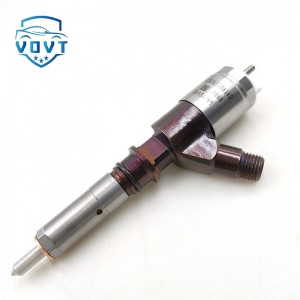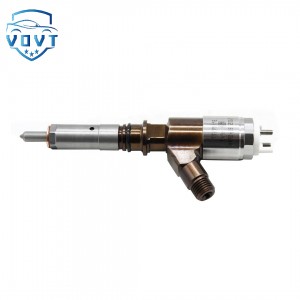New High Quality Diesel Injector 392-0201 20R-1265 11R-0680 392-0202 20R-1266 11R-0279 392-0204 20R-1268 For CAT C3500B
Products Description
| Reference. Codes | C3500B |
| Application | C3500B |
| MOQ | 4PCS |
| Certification | ISO9001 |
| Place of Origin | China |
| Packaging | Neutral packing |
| Quality Control | 100% tested before shipment |
| Lead time | 7~10 working days |
| Payment | T/T, L/C, Paypal, Western Union, MoneyGram or as your requirement |
What impact does abnormal diesel injector pressure have on engine emissions?
Impact of low pressure on emissions
1. Soot (PM) emissions surge
Core reasons:
Insufficient injection pressure (such as more than 30% below the standard value) leads to coarse fuel atomization particles (particle size > 20μm, normally 5-10μm), insufficient mixing of fuel and air, and the formation of a large number of soot precursors (polycyclic aromatic hydrocarbons PAHs) in local hypoxic areas.
Data performance:
When black smoke is visible, the soot concentration can exceed the regulatory limit (such as the PM limit of 0.01g/kWh for National VI b diesel vehicles) by 5-10 times.
Unburned hydrocarbon (HC) emissions increase simultaneously (may increase by 2-3 times) because part of the fuel is not directly discharged without participating in combustion.
2. Increased carbon monoxide (CO) emissions
Mechanism:
Incomplete combustion of fuel in an oxygen-deficient environment generates CO (CO content is <0.1% during normal combustion and can reach 1%-3% during abnormal conditions).
Hazards: CO is a toxic gas. Long-term exposure may cause hypoxia and poisoning in the human body, and increase the load of the three-way catalytic converter (if any). 3. Post-treatment system blockage and failure DPF (diesel particulate filter) overload: Large amounts of soot deposition significantly increase the frequency of DPF regeneration (e.g., regeneration once every 500 kilometers normally, and regeneration every 100 kilometers in abnormal situations). If regeneration is not timely, soot accumulation will lead to increased exhaust pipe back pressure, reduced engine power, and even forced replacement of DPF (cost of about 5,000-20,000 yuan). Decreased efficiency of the SCR system: Unburned HC and soot may contaminate the SCR catalyst (vanadium-based or zeolite-based), reduce the NOx conversion efficiency (e.g., from 95% to below 60%), and cause excessive nitrogen oxide emissions. 2. The impact of excessive pressure on emissions
1. Dramatic increase in nitrogen oxide (NOx) emissions
Core reasons:
High-pressure fuel injection (such as exceeding the standard value by 20%) causes the fuel to be atomized too finely (particle size <3μm), the combustion rate is extremely fast, and the temperature in the cylinder rises sharply (exceeding 2200K), triggering the "thermal nitrogen oxide" generation reaction (O₂ + N₂ → 2NO).
Data performance:
NOx concentration may soar from the normal 500ppm or less to 1500-2000ppm (the National VI b limit is 35mg/kWh, about 800ppm), far exceeding regulatory requirements.
2. Increase in abnormal combustion products
Aldehyde and ketone pollutants:
Fuel pyrolysis under high temperature and pressure generates volatile organic compounds (VOCs) such as formaldehyde and acetaldehyde, which may increase the risk of cancer.
Metal compound emissions:
Excessive pressure causes wear of injector parts (such as peeling of needle valve sealing surface), and metal debris (Fe, Cr, etc.) is discharged with exhaust gas, forming special particulate pollution.
3. Post-treatment system damage
SCR catalyst poisoning:
Sulfur oxides (SOx) produced by high-temperature combustion react with catalysts to form sulfates, covering active sites and causing SCR system failure (catalyst replacement is required, costing about 3,000-10,000 yuan).
DOC (oxidation catalyst) overheating:
Excessive NOx oxidation reaction releases a lot of heat, which may cause the DOC temperature to exceed 900°C, causing the carrier to sinter and break, and lose its catalytic function.
The compound effect of pressure fluctuation on emissions
1. Periodic emission exceeds the standard
If the injection pressure is intermittently abnormal (such as a common rail system pressure sensor failure), it will cause the combustion state of each cylinder to be unstable:
When the pressure of a cylinder is low, a large amount of carbon soot is emitted. After the pressure returns to normal, the other cylinder will cause a surge in NOx due to compensation injection, forming a vicious cycle of "PM-NOx increase and decrease".
Detection difficulties:
Steady-state emission tests may miss such fluctuation problems, but the emission values in actual road driving (RDE) tests may exceed the standard by 2-3 times.
2. Cold start emission deterioration
Pressure is too low:
Poor fuel evaporation in the cold state and poor atomization lead to carbon soot emissions in the cold start stage accounting for 30%-50% of the total daily emissions (normal cold start carbon soot accounts for about 10%-15%).
Pressure is too high:
Premature injection causes unburned fuel to be adsorbed on the cold cylinder wall, which volatilizes during the warm-up process to form HC "pulse emissions", increasing the purification load of the three-way catalytic converter.
Regulatory compliance and impact of annual vehicle inspection
Failure of emission inspection:
During the annual inspection, if the smoke density value (FSN, free acceleration smoke density) exceeds the limit (such as the limit of 0.5m⁻¹ for National VI vehicles), or the OBD detects a fault code of the post-processing system (such as P2463-DPF blockage), the vehicle cannot pass the annual inspection.
Risk of environmental protection penalties:
If it is determined to be "emission fraud" (such as privately shielding the pressure sensor signal), it may face severe penalties such as fines (up to 500,000 yuan) and vehicle recalls.
Countermeasures and emission optimization suggestions
Precisely calibrate the injection pressure:
Use professional equipment (such as the common rail injector test bench) to regularly check the pressure to ensure that the opening pressure of the mechanical injector meets the original factory standard (such as 16-22MPa), and the pressure fluctuation of the common rail system is controlled within ±5%.
Upgrade high-pressure common rail technology:
The traditional mechanical injector is upgraded to an electronically controlled common rail system (such as Bosch CRS 2.2, with a maximum pressure of 180MPa), which accurately controls the injection timing and pressure through the ECU to reduce PM and NOx emissions.
After-treatment system maintenance:
Regularly clean the DPF (every 200,000 kilometers) and replace the SCR filter (every 100,000 kilometers) to ensure the normal operation of the emission control system.

























